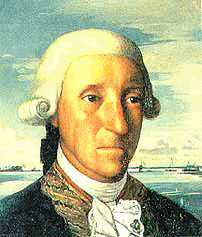
Domingo de Bonechea
Encyclopedia

Getaria
Getaria may refer to:* Getaria , a town located in the Basque province of Gipuzkoa* Getaria , a small village in the Basque province of Labourd...
, Basque Country, died in Tahiti
Tahiti
Tahiti is the largest island in the Windward group of French Polynesia, located in the archipelago of the Society Islands in the southern Pacific Ocean. It is the economic, cultural and political centre of French Polynesia. The island was formed from volcanic activity and is high and mountainous...
in 1775, was an explorer for the Spanish crown. He is known for having tried to incorporate Tahiti
Tahiti
Tahiti is the largest island in the Windward group of French Polynesia, located in the archipelago of the Society Islands in the southern Pacific Ocean. It is the economic, cultural and political centre of French Polynesia. The island was formed from volcanic activity and is high and mountainous...
to the Spanish seaborne empire.
He was the son of Juan Bauptista de Bonechea and Francisca Andonaegui, who married on 25 March 1714,a few months after Domingo's birth.
De Bonechea's voyages were commissioned by the Viceroy of Peru
Peru
Peru , officially the Republic of Peru , is a country in western South America. It is bordered on the north by Ecuador and Colombia, on the east by Brazil, on the southeast by Bolivia, on the south by Chile, and on the west by the Pacific Ocean....
, Manuel de Amat y Juniet
Manuel de Amat y Juniet
Felipe Manuel Cayetano de Amat y de Juniet was a Spanish military officer and colonial administrator. He was the Royal Governor of the Captaincy General of Chile from December 28, 1755 to September 9, 1761, and Viceroy of Peru from October 12, 1761 to July 17, 1776.-Origins and military...
, who was concerned that Captain Cook's explorations might lead to the creation of British bases from which to attack Peru. De Bonechea reached Tahiti only weeks after Cook, and indeed found an axe left there by Cook's expedition. He recorded a great many local native words.
First voyage (1772-1773)
On September 26, 1772 de Bonechea went on an exploratory expedition to Tahiti. He sailed with Tomás Gayangos as his lieutenant on the Aguila from CallaoCallao
Callao is the largest and most important port in Peru. The city is coterminous with the Constitutional Province of Callao, the only province of the Callao Region. Callao is located west of Lima, the country's capital, and is part of the Lima Metropolitan Area, a large metropolis that holds almost...
harbour, Peru
Peru
Peru , officially the Republic of Peru , is a country in western South America. It is bordered on the north by Ecuador and Colombia, on the east by Brazil, on the southeast by Bolivia, on the south by Chile, and on the west by the Pacific Ocean....
.
The expedition reached Tahiti on November 13. He anchored opposite Tautira village which de Bonechea christened "Santísima Cruz".
De Bonechea forbade himself and his crew any sexual relations with local women, which surprised the Tahitians
Tahitians
The Tahitians, or Maohis, are indigenous peoples of Tahiti and thirteen other Society Islands, as well as the modern population of these lands of mixed ancestry . The Tahitians are one of the most significant indigenous Polynesian peoples of Oceania....
greatly. He left Tahiti on December 20 and reached Valparaíso
Valparaíso
Valparaíso is a city and commune of Chile, center of its third largest conurbation and one of the country's most important seaports and an increasing cultural center in the Southwest Pacific hemisphere. The city is the capital of the Valparaíso Province and the Valparaíso Region...
on February 21, 1773.
Second Voyage (1774-1775)
The aim of this expedition was the annexation of Tahiti to the Spanish crown, with the approval and encouragement of King Carlos IIICharles III of Spain
Charles III was the King of Spain and the Spanish Indies from 1759 to 1788. He was the eldest son of Philip V of Spain and his second wife, the Princess Elisabeth Farnese...
, and to convert its inhabitants. Two ships, the Aguila and the Jupiter left Callao on September 20, 1774. After winning over Tu, the most important king of the Tahitians, de Bonechea's men were allowed to establish a mission.
However, de Bonechea died on January 20, 1775 in Tahiti, where his grave was rediscovered in the 20th century.
The Spanish mission on Tahiti was abandoned on November 12 the same year and the whole enterprise came to an early end.
See also
- BuenecheaBuenecheaBuenechea is a the Spanish spelling of a Basque surname which also occurs in the variants Bonechea, Buonechea, Boenechea and Bonachea. The modern Basque spellings are Buenetxea and Bonetxea...
Regarding his family name. - TahaneaTahaneaTahanea Atoll is an atoll of the Tuamotu Archipelago in French Polynesia. It is located 12 km to the east of Faaite Atoll.Tahanea Atoll is quite large. It measures 48 km in length with a maximum width of 15.2 km. The southern reef fringing the atoll is wider than the northern one,...
& TatakotoTatakotoTatakoto is an atoll in the Tuamotu group in French Polynesia.Tatakoto is one of the more isolated atolls of the Tuamotus. It situated in the east of the archipelago, 1,182 km from Tahiti. This atoll is 14 km long and 3.5 km wide. It has one large island and 65 islets separated by...
, two atolls visited by Domingo de Bonechea before any other recorded European mariner.

